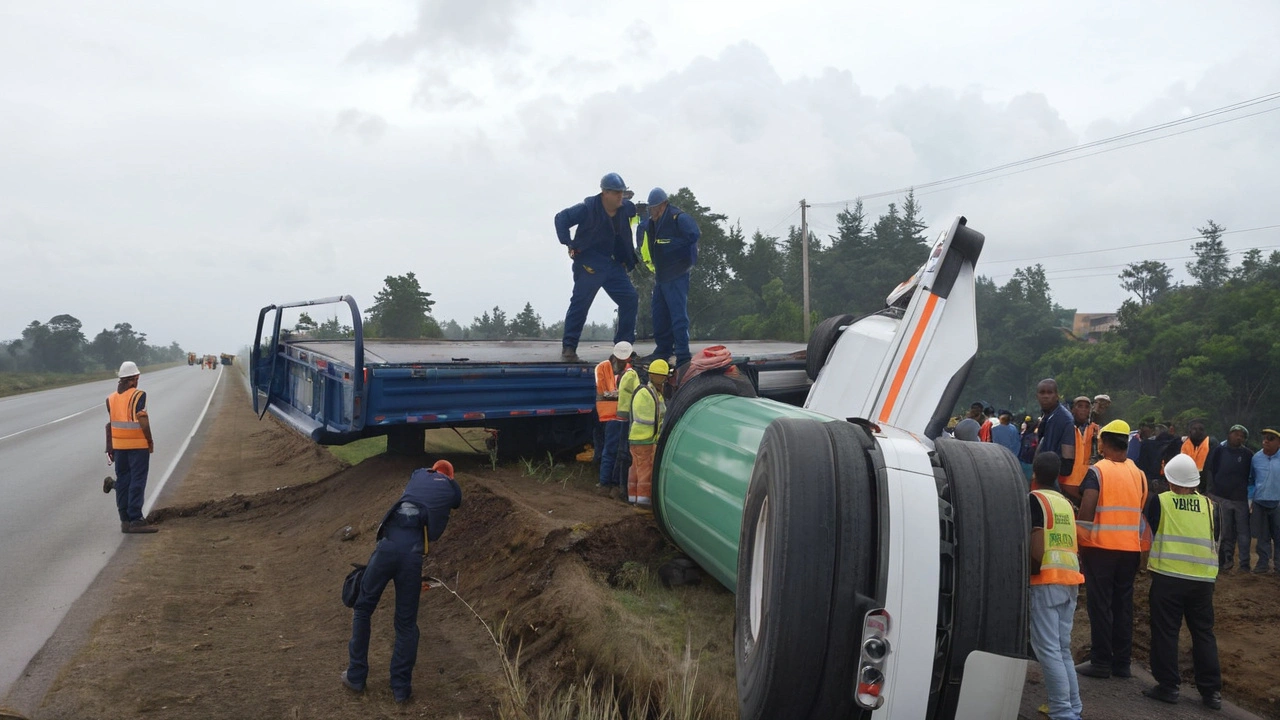Urgent Plea for Public Safety in Kiambu County
The tranquil region of Kiambu County was thrown into a state of emergency following a truck accident that led to the spillage of sodium cyanide, a chemical recognized for its highly toxic nature. Local officials have since been working tirelessly to contain the situation while urging residents who seized the chemical to return it in the interest of their safety and the well-being of the community. The truck, transporting sodium cyanide from Mombasa to Congo, met with an unfortunate mishap in the Kambembe area of Rironi. The accident has not only alarmed local authorities but also put the community at significant risk.
The Toxic Nature of Sodium Cyanide
Public Health Principal Secretary Mary Muthoni has been at the forefront, emphasizing the sheer dangers posed by sodium cyanide. She explains that even minimal exposure to the chemical, whether through ingestion or inhalation, can be fatal. Immediate symptoms include headache, dizziness, and shortness of breath, progressing swiftly to nausea and vomiting. Severe exposure can bring about loss of consciousness and convulsions within mere minutes. The situation is dire, as prolonged or repeated exposure to sodium cyanide carries long-lasting health repercussions such as neurological damage, thyroid dysfunction, and cardiovascular issues. This underscores the urgent need for community cooperation.
Environmental Threats
Beyond the immediate health risks to humans, sodium cyanide poses a grave threat to the environment. The chemical's accidental release into waterways near the truck spill site can decimate aquatic life, resulting in substantial fish kills and prolonged harm to aquatic ecosystems. Environmental scientists warn that the damage could extend for years, disrupting local biodiversity and affecting livelihoods that depend on these water bodies. Environmentalists and local officials are thus equally concerned about limiting the scope of contamination as they are about human health risks.

Official Response and Community Call to Action
In a bid to manage the crisis, the Ministry of Health has issued explicit directives aimed at safeguarding the residents. They've urged locals to avoid the affected areas and to cooperate fully with emergency response teams working around the clock to decontaminate the site. Emergency services have been mobilized swiftly, and their efforts to secure the perimeter and initiate cleanup operations have been commendable. However, the spillage's impact remains multifaceted and complex, necessitating a comprehensive response.
Addressing Looting Concerns
Complicating matters further, reports surfaced of residents looting sodium cyanide from the overturned truck. Such behavior, driven perhaps by curiosity or perceived opportunity, has the potential to aggravate the crisis manifold. In an unprecedented step, Rironi area chief, Charles Kariuki, has called upon the culprits to return the dangerous chemical. Assurances have been given that no legal repercussions will be faced by those who comply, an indication of the gravity of the situation. The focus here is clearly on mitigating risks and ensuring public health and safety.
Public Education and Preventive Measures
This incident has ignited urgent discussions on the need for public education and the strengthening of preventive measures surrounding the handling and transportation of hazardous chemicals. Residents and local officials alike believe that a more informed public is crucial in averting similar crises in the future. Awareness campaigns, safety drills, and stringent regulations on the transportation of toxic substances are being considered as part of a multi-pronged strategy to enhance community resilience and safety.

A Call for Unity and Vigilance
As Kiambu County navigates this episode, the need for unity and collective resolve becomes ever more evident. Local leaders, health officials, and residents must work in tandem to overcome the immediate hazards and to forge a robust framework for handling such emergencies. This community's plight is a stark reminder of the intertwined relationship between human health and environmental stewardship. By addressing this crisis decisively and thoughtfully, Kiambu County can emerge stronger and better prepared for future challenges.
Looking Forward
The incident involving the sodium cyanide spillage is still unfolding, with many questions about its long-term implications and the full extent of the contamination. Nevertheless, the coordinated efforts of local authorities, the community's proactive steps, and the pragmatic approach taken by officials offer a glimmer of hope. This situation stands as a powerful case study on the importance of preparedness, quick response, and the need for continuous education on chemical safety and environmental protection.







Subhash Choudhary
July 21, 2024 AT 20:30 PMMan, that sodium cyanide spill in Kiambu sounds like a nightmare. I saw the news and the first thing on my mind is how quickly they’re moving the cleanup crews. It’s good that the officials are asking people to hand the chemicals back, because anyone touching that stuff is playing with death. The area’s water could get seriously messed up if it seeps into the streams. Hope everyone stays safe and follows the directions.
Ethan Smith
July 21, 2024 AT 20:33 PMThe incident highlights how fragile our supply chains can be when hazardous materials are involved.
Transporting sodium cyanide across long distances without robust safeguards inevitably creates risk.
While it is understandable that locals might be curious, the chemical’s toxicity leaves no room for casual handling.
Even a minuscule amount can cause severe neurological damage within minutes, as the health secretary rightly emphasized.
The authorities’ decision to forgo legal action for those who return the material is a pragmatic step that prioritizes public health over punitive measures.
It also sets a constructive precedent for community cooperation in future emergencies.
From an environmental perspective, the potential contamination of waterways could decimate fish populations and disrupt local livelihoods.
This underscores the need for stricter regulations on the transport routes of such dangerous substances.
I think a comprehensive risk assessment should be mandated for any cargo classified as high‑hazard.
Moreover, emergency response teams must be equipped with specialized equipment to neutralize cyanide quickly.
Public education campaigns are essential; people need to understand that “just a little bit” is not a safe quantity.
It would be beneficial for local schools to incorporate basic chemical safety modules into their curricula.
In the meantime, I commend the swift mobilization of health officials and environmental scientists working together.
Their combined effort serves as a model for integrated crisis management.
Ultimately, this episode should motivate policymakers to revisit transport guidelines and community outreach strategies to prevent repeats.
Evelyn Monroig
July 21, 2024 AT 20:35 PMLooks like they’re trying to cover something up-maybe the spill wasn’t an accident at all. Who knows what else was in that truck besides cyanide? The government’s quick “no punishment” promise feels like a distraction tactic to keep us quiet. If they really cared, they’d keep the whole operation under lock‑down and not let strangers mess with the cargo.
Gerald Hornsby
July 21, 2024 AT 20:53 PMWhat a tragic drama unfolding in Kiambu, the stakes feel like a Shakespearean tragedy 😱
Hina Tiwari
July 21, 2024 AT 20:56 PMI feel really bad for the families living near the spill, thier worries are legit. It’s scary to think about how this could affect the kids and elders in the area. Hopefully the officials keep pushing the community to hand back the chemical before anything worse happens.
WILL WILLIAMS
July 21, 2024 AT 20:58 PMLet's rally together, folks! This is a perfect chance to show community spirit and protect our environment with bold, colorful action.